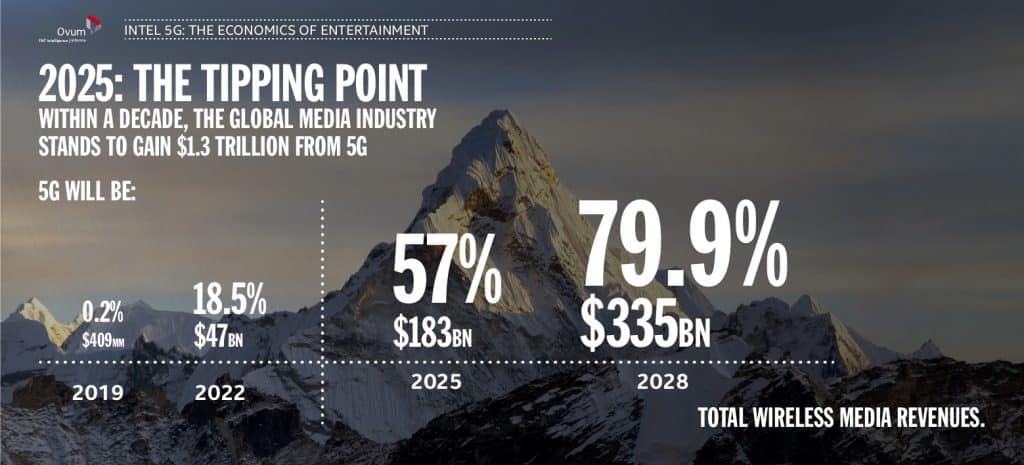Intel is making some impressive predictions about how 5G will impact media and entertainment revenues. According to the newly released “5G Economics of Entertainment Report” commissioned by Intel and conducted by Ovum, 5G-enabled applications and services will drive up the revenue of M&E industry to $1.3T by 2028.
The report cites 2025 as a 5G Tipping Point for M&E Revenue.
Source: intel
According to the report, 57 percent of global wireless media revenue will be generated by using the ultra-high-bandwidth capabilities of 5G networks and 5G-enabled services and applications. The low latency of these blazing-fast networks means live streaming and heavy downloads will happen in the blink of an eye.
Key Drivers of future M&E Growth
Content innovation and content consumption are two significant drivers of this predicted significant growth in the media and entertainment industry.
Content Innovation
5G will start operating at maximum efficiency from 2022 onwards. It will lead to the mass adoption of augmented reality (AR) and virtual reality (VR), and the emergence of 3D holographics, advanced interactive entertainment, haptic suits, and innumerable other forms of futuristic tech. Immersive and new media applications will reach an unprecedented scale by 2028, driving nearly $67bn annually, which is equivalent to the value of the entire mobile media market last year.
5G media revenue can be categorized as follows:
- Enhanced mobile media: Paid-for and bundled-in traditional media including music, video and games on 5G networks.
- Enhanced mobile advertising: Mobile display advertising such as videos, banners, in-game placement over 5G, and new visual advertising formats that may appear in VR and AR environments.
- Home broadband and TV: Using 5G as the primary home internet connection bundled with a TV package.
- New Immersive interactive media: AR and VR content and apps, as well as cloud gaming delivered over 5G. Though AR, VR, and cloud gaming are not new concepts, 5G lets people unlock their full potential to the mass-market level. The Intel report predicts that 5G, AR, VR and cloud gaming combined will yield the M&E industry annual revenues of $47.7 million in 2028.
- New Media: New applications, such as self-driving car entertainment, 3D holographic displays, and connected haptic suits that 5G will bring into existence in the future.
Content Consumption
5G networks and 5G-enabled devices will create even more consumer desire for content than we see today. Enhance mobile broadband will deliver a seamless experience for mobile streaming services such as Netflix and Spotifiy. Zero latency between streaming sources and viewers will call a new-generation of live-streaming services for sports and other live events. Lower cost per bit will bring affordable and truly unlimited mobile data packages, to best fit heavy media usage.
The average monthly traffic per 5G subscriber will increase from 11.7GB in 2019 to 84.4GB per month in 2028, 90% of which will count for video content.
Unlike 4G which taught customers to sacrifice quality for speed, 5G offers super-fast and reliable livestreaming with little to no buffering. These remarkable enhancements in speed and quality during media consumption will lead to radical innovations in premium content, such as multi-player mobile games and dedicated VR sports, opening up new revenue streams for the industry.
Other Contributing Factors in M&E growth
Mobile display advertising market is expected to hit $178bn globally by 2028, thanks to 5G. The 5G technology will help combat the key challenges of scale, delivery and measurements.
Mobile video revenues over 5G will growth by 85% between 2021 and 2028. 5G will serve as a major asset for network providers in media, B2B and B2C, enabling operators to capitalize on mobile media growth by selling 5G network capabilities to OTT video service providers. Highly responsive haptic suits paired with advanced VR capabilities will help generate over $5bn annually by 2028.
5G Driving Future Entertainment
5G will inevitably shake up the media and entertainment industry. Customers are hungry for speed and quality, and 4G has exhausted the possibilities at this speed. The switch from 4G to 5G will bring speed, quality and reliability, which will be a driving force in giving consumers access to new and better content.
